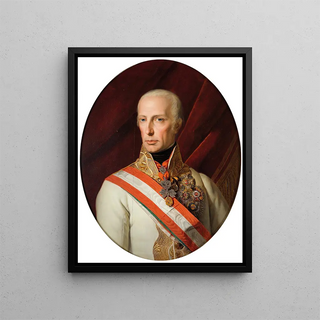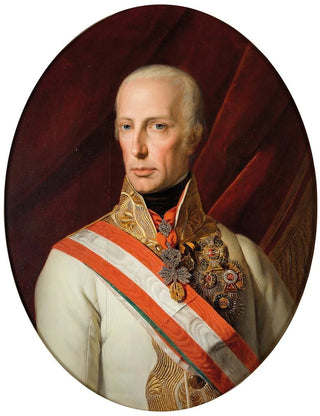Art print | Kaiser François Ier - Ferdinand Georg Waldmüller Source: Reproduction | Kaiser François Ier - Ferdinand Georg Waldmüller


View from behind

Frame (optional)
Napoleon III, Emperor of the French, by Ferdinand Georg Waldmüller – Captivating Introduction
In the vast panorama of art history, certain works stand out for their ability to capture the essence of a particular era and personality. "Kaiser François Ier" by Ferdinand Georg Waldmüller is one of these iconic creations. This painting, which depicts the sovereign with striking majesty, evokes not only the grandeur of the emperor but also the historical and cultural context of the 19th century. Waldmüller, as a master of portraiture, manages to transcend mere visual representation to offer the viewer an immersion into the royal universe. The light, colors, and meticulous details of this artwork invite prolonged contemplation, allowing one to feel the full power and dignity of François Ier.
Style and uniqueness of the work
Waldmüller’s work is characterized by a realistic style and scrupulous attention to detail. In "Kaiser François Ier," every element, from the richly adorned costume to the subtle expressions on the face, is carefully crafted. The choice of colors, both vivid and harmonious, helps create an atmosphere that is both solemn and lively. The play of light, which illuminates the sovereign’s face while leaving certain aspects of the composition in shadow, reinforces the idea of mystery and grandeur. This portrait does not merely depict a man; it embodies an era, a history, and an ideal. The way Waldmüller manages to balance realism and idealism in his work makes this piece a perfect example of 19th-century portrait art.
The artist and his influence
Ferdinand Georg Waldmüller, born in 1793, is an essential figure of Austrian Romanticism. His career is marked by a desire to depict daily life as well as historical figures with rare emotional intensity. Waldmüller was able to capture the aspirations of his time, blending tradition and innovation. His approach to portraiture, which emphasizes the psychology of his subjects, influenced many contemporary and later artists. By choosing to paint historical figures like François Ier, he also contributed to the reevaluation of Austrian cultural heritage. His work is a testament to

Matte finish

View from behind

Frame (optional)
Napoleon III, Emperor of the French, by Ferdinand Georg Waldmüller – Captivating Introduction
In the vast panorama of art history, certain works stand out for their ability to capture the essence of a particular era and personality. "Kaiser François Ier" by Ferdinand Georg Waldmüller is one of these iconic creations. This painting, which depicts the sovereign with striking majesty, evokes not only the grandeur of the emperor but also the historical and cultural context of the 19th century. Waldmüller, as a master of portraiture, manages to transcend mere visual representation to offer the viewer an immersion into the royal universe. The light, colors, and meticulous details of this artwork invite prolonged contemplation, allowing one to feel the full power and dignity of François Ier.
Style and uniqueness of the work
Waldmüller’s work is characterized by a realistic style and scrupulous attention to detail. In "Kaiser François Ier," every element, from the richly adorned costume to the subtle expressions on the face, is carefully crafted. The choice of colors, both vivid and harmonious, helps create an atmosphere that is both solemn and lively. The play of light, which illuminates the sovereign’s face while leaving certain aspects of the composition in shadow, reinforces the idea of mystery and grandeur. This portrait does not merely depict a man; it embodies an era, a history, and an ideal. The way Waldmüller manages to balance realism and idealism in his work makes this piece a perfect example of 19th-century portrait art.
The artist and his influence
Ferdinand Georg Waldmüller, born in 1793, is an essential figure of Austrian Romanticism. His career is marked by a desire to depict daily life as well as historical figures with rare emotional intensity. Waldmüller was able to capture the aspirations of his time, blending tradition and innovation. His approach to portraiture, which emphasizes the psychology of his subjects, influenced many contemporary and later artists. By choosing to paint historical figures like François Ier, he also contributed to the reevaluation of Austrian cultural heritage. His work is a testament to






